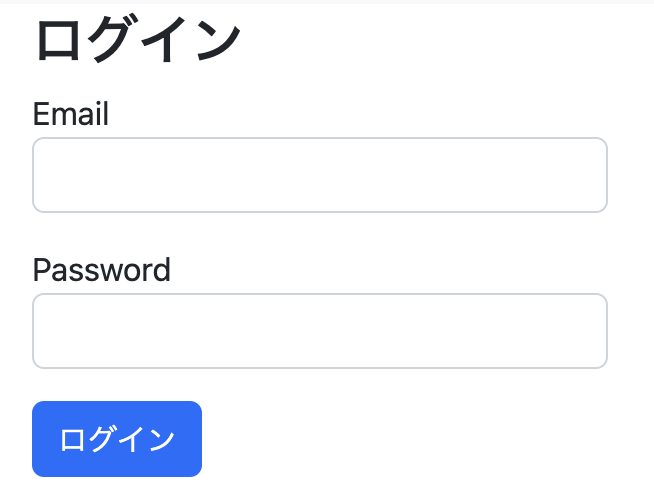ユーザの作成
Userモデルにパッと必要そうなカラムを
まず入れてみる。
rails g model User name:string email:string
一旦migrationする。
rails db:migrate
ログイン機能とかがないのであれば、
もしかしたら、これでも足りる(?)のかもしれないが、
ログインするためには、
passwordが必要であろう。
セキュリテイーとかをガン無視するのであれば、
単にpasswordカラムをUserモデルに追加して、
そのまま平文で保存すればいいと思うが、
流石にそれはまずいということで、
has_secure_passwordを使うことにする。
そのためには、password_digestカラムが必要になるので、
password_digestをUserモデルに追加する。
rails generate migration add_password_digest_to_users password_digest:string
rails db:migrate
これでusersテーブルは、
次のようになるだろう。
create_table "users", force: :cascade do |t|
t.string "name"
t.string "email"
t.datetime "created_at", null: false
t.datetime "updated_at", null: false
t.string "password_digest"
end
bcryptも必要なので、
追加する。
gem 'bcrypt'
bundle
これでhas_secure_methodが使えるようになるので、
追記する。
class User < ApplicationRecord
has_secure_password
end
ログイン機能の簡単なテスト
まずは、簡単なテストから作成してみる。
require 'rails_helper'
RSpec.describe 'Sessions', type: :request do
let!(:user) { create(:user) }
describe 'GET /login' do
context 'ログイン画面' do
it 'success' do
get login_path
expect(response).to have_http_status(:success)
end
end
end
describe 'POST /login' do
context 'ログイン' do
it 'sessionにuser_idが格納される' do
post login_path, params: { session: { email: 'test@example.com', password: 'foobar' } }
expect(!!session[:user_id]).to eq true
end
end
end
end
このテストが通るように、
まずはルーティングの設定をする。
get 'login', to: 'sessions#new'
post 'login', to: 'sessions#create'
これでlogin_pathが有効になる。
routes.rbでsessionsコントローラーの
newとcreateアクションに割り当てたから、
そちらも作成する。
class SessionsController < ApplicationController
def new
end
def create
end
end
newの方はログインフォームを使用するので、
viewも作成する。
<% provide(:title, "ログイン画面") %>
<h2>ログイン</h2>
<div class="col-md-6">
<%= form_with(url: login_path, scope: :session, local: true) do |f| %>
<div class="form-group mb-3">
<%= f.label :email %>
<%= f.email_field :email, class: 'form-control' %>
</div>
<div class="form-group mb-3">
<%= f.label :password %>
<%= f.password_field :password, class: 'form-control' %>
</div>
<%= f.submit "ログイン", class: "btn btn-primary" %>
<% end %>
</div>
この図のとおり、
emailとpasswordがparamsとして送られてくる。
ログインのプロセスとしては、
emailからUserモデルを検索し、
そのユーザのpasswordが入力されたものと一致するかを
判断すればいい。
その際、authenticateメソッドを使用する。
class SessionsController < ApplicationController
skip_before_action :check_logged_in, only: [:new, :create]
def new
end
def create
user = User.find_by(email: params[:session][:email])
if user && user.authenticate(params[:session][:password])
log_in user
redirect_to root_path
else
flash.now[:danger] = 'メールアドレスかパスワードが違います'
render 'new'
end
end
def destroy
log_out
redirect_to root_path
end
end
authenticateできたら、
log_inするので、そのメソッドを実装する。
module SessionsHelper
def current_user
return unless (user_id = session[:user_id])
@current_user ||= User.find_by(id: user_id)
end
def log_in(user)
session[:user_id] = user.id
end
def log_out
session.delete(:user_id)
@current_user = nil
end
end
sessions_helperに定義したので、
application_controller.rbで読み込む
class ApplicationController < ActionController::Base
include SessionsHelper
before_action :check_logged_in
def check_logged_in
return if current_user
redirect_to root_path
end
end
ログインは、結局の所、
session[:user_id] = user.id
に尽きる。
あとは、current_userとかを定義して、
ifとかで条件分岐して、
ログインした画面を作り上げている。
バリデーションなどは実装していないので、
不十分だが、ログイン機能実装の流れは
このような感じだと思う。
